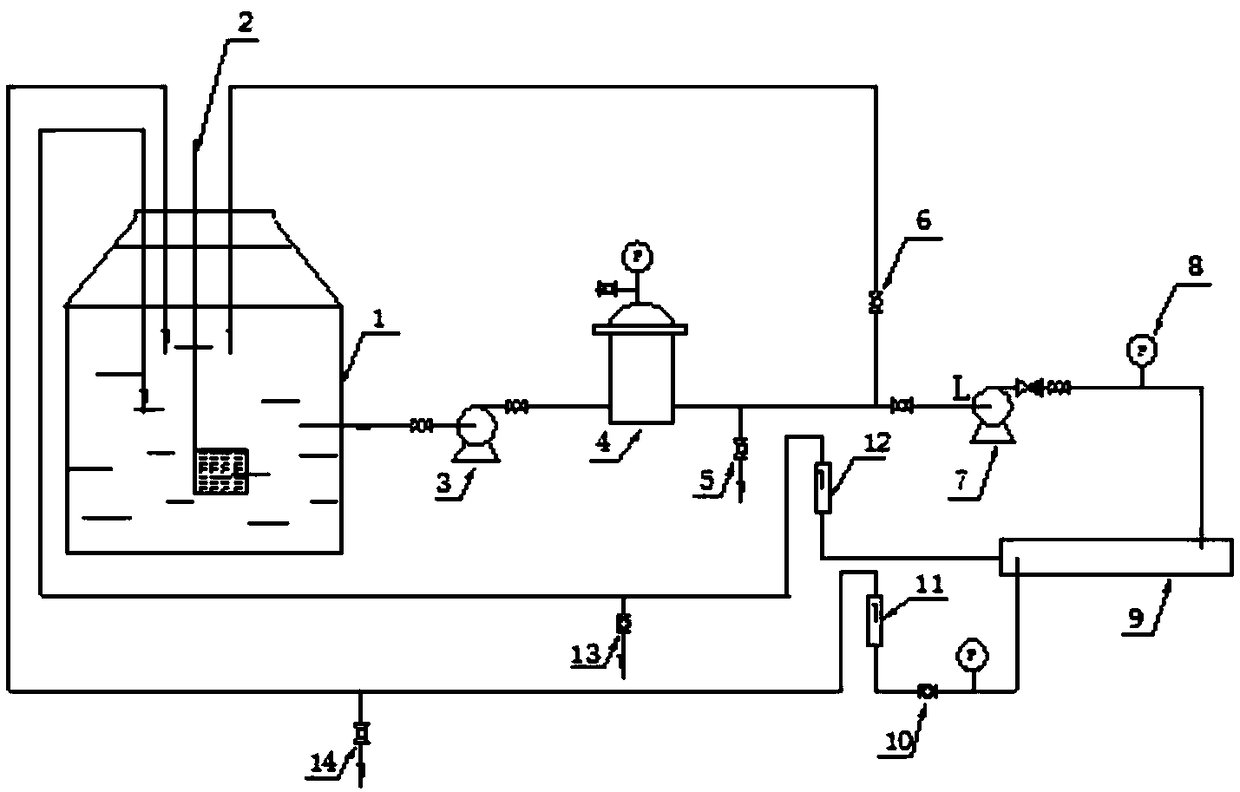Testing method for de-boron rate of coiled seawater reverse osmosis membrane element
A technology of reverse osmosis membrane and testing method, which is applied in seawater treatment, semi-permeable membrane separation, chemical instruments and methods, etc., can solve the problem of deviation from the actual application conditions of seawater reverse osmosis membrane elements, lack of comparability of different reverse osmosis membrane elements, The test results do not match the actual application performance and other problems, and achieve the effect of easy promotion, low cost and strong practicability
- Summary
- Abstract
- Description
- Claims
- Application Information
AI Technical Summary
Problems solved by technology
Method used
Image
Examples
Embodiment 1
[0026] Rinse the TM800K-8040 type seawater reverse osmosis membrane element produced by Japan Toray Company with deionized water or distilled water with a flow rate of 5L / h at room temperature for 5 minutes for later use; use it in the water tank of the reverse osmosis membrane element permeability test device Prepare a 30000mg / L sodium chloride solution with ionized water, then add boric acid to make the boron concentration reach 5mg / L, and adjust the pH value of the solution to 7.5 with sodium hydroxide; put the washed seawater reverse osmosis membrane elements into the membrane shell, concentrate When the water regulating valve is fully open, turn on the water supply pump to run the system at low pressure for 3 minutes, and discharge the air in the system; turn on the energy recovery of the test device in turn, and the high pressure pump to boost the inlet water pressure to 5MPa, with a recovery rate of 7% , the temperature of the test solution was adjusted to 24°C, and the ...
Embodiment 2
[0031]Rinse the TM800K-8040 seawater reverse osmosis membrane element produced by Toray Corporation of Japan with deionized water or distilled water with a flow rate of 6.5L / h for 8 minutes at room temperature; use it in the water tank of the reverse osmosis membrane element permeability test device Prepare 32000mg / L sodium chloride solution with deionized water, then add boric acid to make the boron concentration reach 6.5mg / L, adjust the pH value of the solution to 8 with sodium hydroxide; put the washed seawater reverse osmosis membrane elements into the membrane shell , the concentrated water regulating valve is in the fully open state, turn on the water supply pump, make the system run at low pressure for 4 minutes, and discharge the air in the system; turn on the energy recovery of the test device in turn, and the high pressure pump will boost the inlet water pressure to 5.5MPa, and recover 8%, the temperature of the test solution was adjusted to 25°C, and the sampling te...
Embodiment 3
[0036] Rinse the TM800K-8040 seawater reverse osmosis membrane element produced by Japan Toray Company with deionized water or distilled water with a flow rate of 8L / h for 10 minutes at room temperature; use it in the water tank of the reverse osmosis membrane element permeability test device Prepare 34000mg / L sodium chloride solution with ionized water, then add boric acid to make the boron element concentration reach 8mg / L, and adjust the pH value of the solution to 8.5 with sodium hydroxide; put the washed seawater reverse osmosis membrane element into the membrane shell, concentrate When the water regulating valve is fully open, turn on the water supply pump to run the system at low pressure for 5 minutes, and discharge the air in the system; turn on the energy recovery of the test device in turn, and the high-pressure pump to boost the inlet water pressure to 6MPa, with a recovery rate of 9% , the temperature of the test solution was adjusted to 26°C, and the sampling test...
PUM
 Login to View More
Login to View More Abstract
Description
Claims
Application Information
 Login to View More
Login to View More - R&D
- Intellectual Property
- Life Sciences
- Materials
- Tech Scout
- Unparalleled Data Quality
- Higher Quality Content
- 60% Fewer Hallucinations
Browse by: Latest US Patents, China's latest patents, Technical Efficacy Thesaurus, Application Domain, Technology Topic, Popular Technical Reports.
© 2025 PatSnap. All rights reserved.Legal|Privacy policy|Modern Slavery Act Transparency Statement|Sitemap|About US| Contact US: help@patsnap.com



